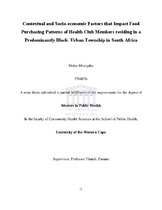| dc.contributor.advisor | Puoane, Thandi | |
| dc.contributor.author | Muzigaba, Moïse | |
| dc.date.accessioned | 2014-07-04T11:11:14Z | |
| dc.date.available | 2014-07-04T11:11:14Z | |
| dc.date.issued | 2010 | |
| dc.identifier.uri | http://hdl.handle.net/11394/3447 | |
| dc.description | Magister Public Health - MPH | en_US |
| dc.description.abstract | Background: It is gradually being recognized that understanding individual-level
socioeconomic and environmental predictors of food purchasing and thus healthy eating, is
imperative in order to develop appropriate nutrition and health interventions. Understanding the
complex world of food choice requires a meticulous examination of stimuli and deterrents of
food choice all of which should be viewed comprehensively to include micro-level
compositional socioeconomic aspects of individuals as well as macro-level contextual influences
of food cost, availability and accessibility.
Aim: This study sought to uncover some of the widely known environmental (contextual) and
compositional (individual-level) socioeconomic factors that influence Health Club Members’
(HCMs) ability to access and afford healthy foods within the community where they live.
Study design: The research employed both descriptive quantitative and qualitative study
designs.
[VI]
Study population and sample: The target population which was also the sample comprised 50
Health Club Members who were residing in Harare and the surrounding area within Khayelitsha
at the time of the study.
Data collection and analysis: Data was collected by means of face to face quantitative
interviews with 46 HCMs using questionnaires, in-depth interviews with 10 HCMs, Key
informant interviews with 2 Community Health Workers, as well as observations of the
community food environment. Quantitative data was analyzed using SPSS version 16.0 and MS
Excel 2007 for Windows. Qualitative analysis was executed using framework and content
analysis techniques.
Results and conclusion: The study established that low socioeconomic status, poor access to
healthy food choices, and lack of constant availability of such foods were primary challenges
facing some of the HCMs in their quest to afford and access healthy food. In order to promote
access to and availability of affordable healthy foods in the study setting, there may be a need for
addressing not only individual socioeconomic challenges but also more upstream environmental
drivers of food purchasing. | en_US |
| dc.description.sponsorship | Background: It is gradually being recognized that understanding individual-level
socioeconomic and environmental predictors of food purchasing and thus healthy eating, is imperative in order to develop appropriate nutrition and health interventions. Understanding the complex world of food choice requires a meticulous examination of stimuli and deterrents of food choice all of which should be viewed comprehensively to include micro-level compositional socioeconomic aspects of individuals as well as macro-level contextual influences of food cost, availability and accessibility.Aim: This study sought to uncover some of the widely known environmental (contextual) and compositional (individual-level) socioeconomic factors that influence Health Club Members’(HCMs) ability to access and afford healthy foods within the community where they live.Study design: The research employed both descriptive quantitative and qualitative study
designs.[VI]Study population and sample: The target population which was also the sample comprised 50 Health Club Members who were residing in Harare and the surrounding area within Khayelitsha at the time of the study.Data collection and analysis: Data was collected by means of face to face quantitative interviews with 46 HCMs using questionnaires, in-depth interviews with 10 HCMs, Key informant interviews with 2 Community Health Workers, as well as observations of the
community food environment. Quantitative data was analyzed using SPSS version 16.0 and MS Excel 2007 for Windows. Qualitative analysis was executed using framework and content analysis techniques.Results and conclusion: The study established that low socioeconomic status, poor access to healthy food choices, and lack of constant availability of such foods were primary challenges facing some of the HCMs in their quest to afford and access healthy food. In order to promote
access to and availability of affordable healthy foods in the study setting, there may be a need for addressing not only individual socioeconomic challenges but also more upstream environmental drivers of food purchasing. | en_US |
| dc.language.iso | en | en_US |
| dc.subject | Contextual | en_US |
| dc.subject | Compositional | en_US |
| dc.subject | Socioeconomic | en_US |
| dc.subject | Factors | en_US |
| dc.subject | Dietary quality | en_US |
| dc.subject | Health club members | en_US |
| dc.subject | Black-Urban township | en_US |
| dc.subject | South Africa | en_US |
| dc.title | Contextual and socio-economic factors that impact food purchasing patterns of health club members residing in a predominantly black- urban township in South Africa | en_US |
| dc.type | Thesis | en_US |

